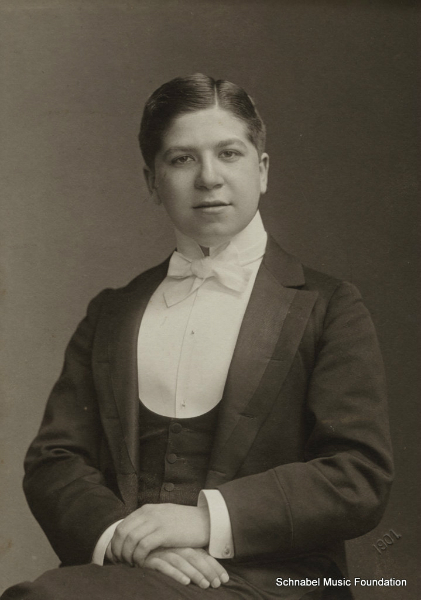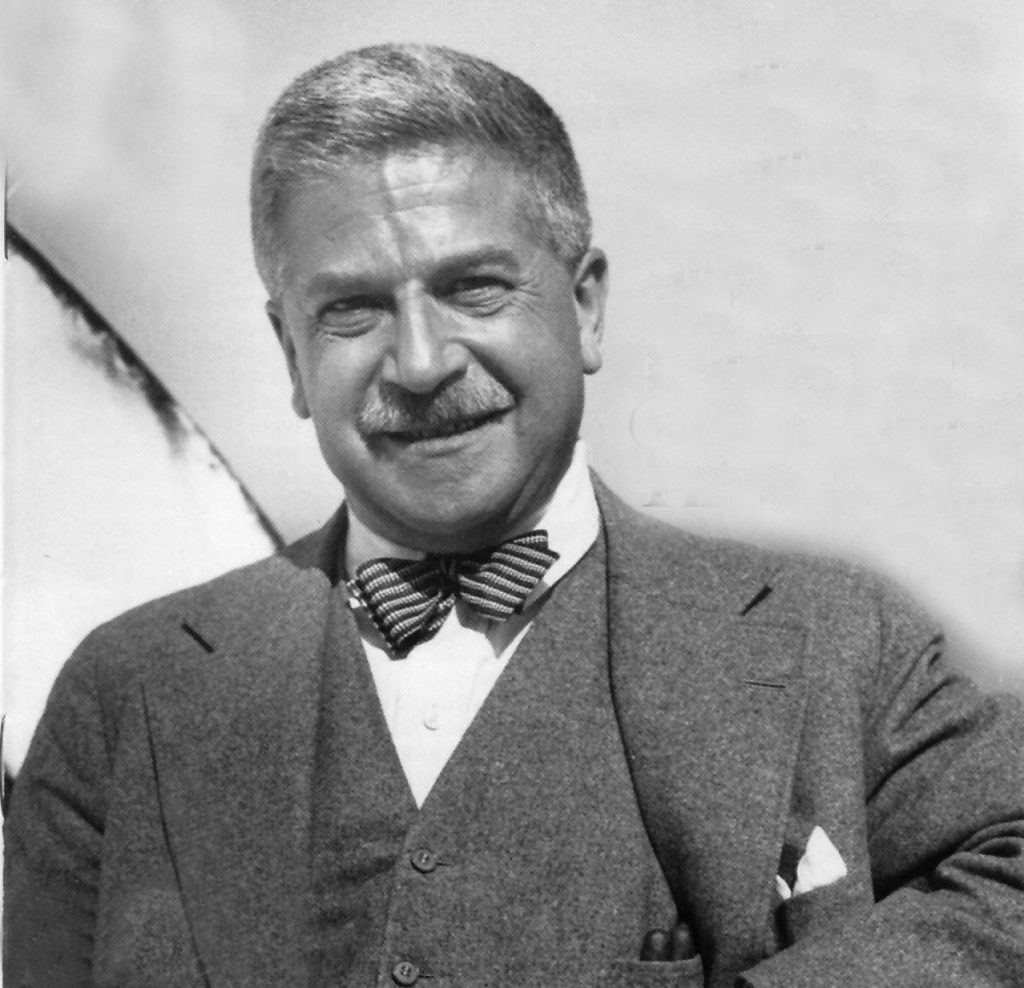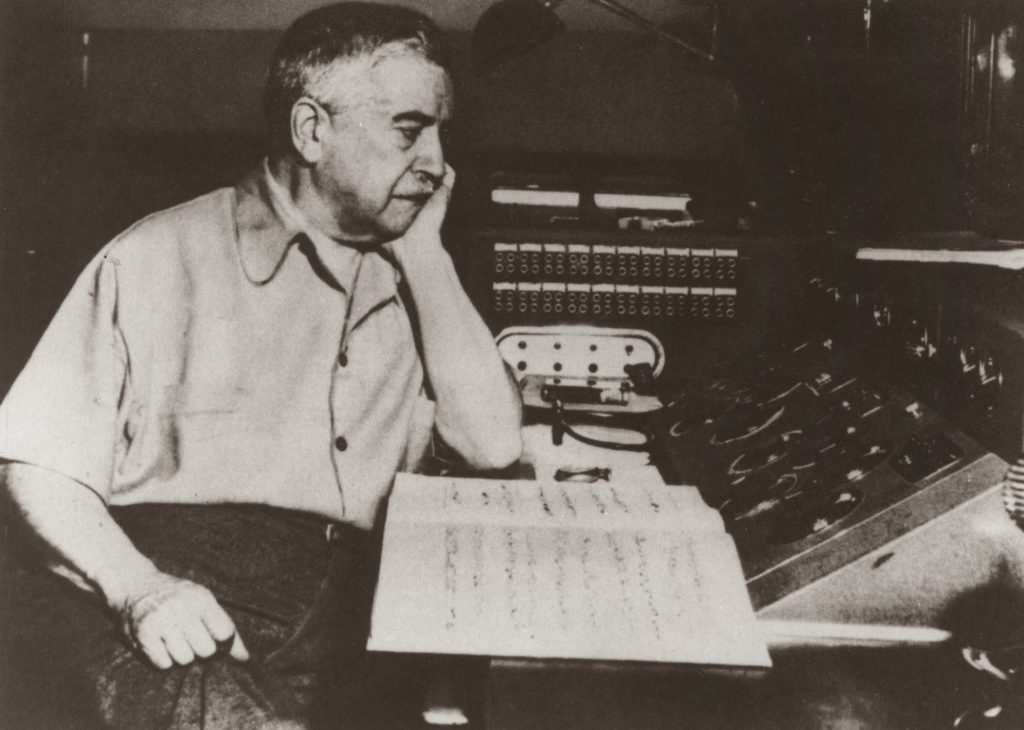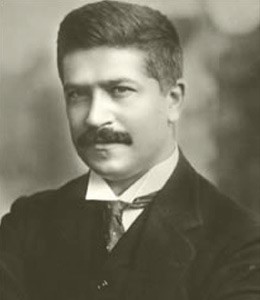


Artur Schnabel (* 17. April 1882 in Kunzendorf bei Biala (Galizien); † 15. August 1951 in Axenstein nahe Morschach, Kanton Schwyz, Schweiz) war ein österreichischer Pianist und Komponist.
Leben
Artur Schnabel wurde in einer jüdischen Familie geboren und war das jüngste von drei Kindern. Seine Eltern waren Isidor Schnabel, ein Textilhändler, und dessen Ehefrau Ernestine Taube, geborene Labin. Er wuchs in bescheidenen Verhältnissen auf. Noch als Kind zog er mit der Mutter und beiden Schwestern nach Wien. Dort hatte er 1890 sein Debüt als Pianist. Der kaum 12-jährige blieb als Logiergast in Wien, während Mutter und Schwestern für die folgenden drei Jahre zum Vater nach Westgalizien zurückkehrten.
Nach Klavierunterricht bei „Madame Essipoff“ wurde er Schüler ihres (Ex-)Mannes Theodor Leschetizky.[4] Unentgeltlichen Unterricht in Musiktheorie und Komposition erhielt er von Eusebius Mandyczewski, den er auch ins Archiv der Gesellschaft der Musikfreunde begleiten durfte. Mandyczewski ließ seinen jungen Schüler an den sonntäglichen Ausflügen mit Johannes Brahms teilnehmen, ohne dass dieser besondere Notiz von dem Kind genommen hätte.
1899 wurde noch vor der Verheiratung seine Tochter Elizabeth Rostra (1899–1995) geboren. 1900 zog Schnabel nach Berlin und heiratete dort 1905 die Altistin Therese Behr-Schnabel (1876–1959), mit der er bei zahlreichen Liederabenden auftrat. 1911 spielte er zusammen mit dem Geiger Karl Klingler, dem Cellisten Arthur Williams und den Berliner Philharmonikern das Tripelkonzert von Ludwig van Beethoven, was ihm internationale Beachtung brachte.
Schnabel verbanden enge Freundschaften mit Ernst Krenek, Eduard Erdmann und Hans Jürgen von der Wense. In einer Aufführung von Schönbergs Pierrot lunaire spielte er den Klavierpart. Unmittelbar nach der Machtübernahme Hitlers 1933 emigrierte er mit seiner Familie nach Großbritannien. Von 1933 bis 1939 lebte die Familie Schnabel im Sommer in Tremezzo am Comer See in der Villa Ginetta. Dort befand sich auch die Schnabel-Schule. Diese wurde von Peter Diamand, dem späteren Leiter des Holland-Festivals, geleitet. Artur Schnabel unterrichtete die Pianisten, seine Frau Therese die Sänger und der von den Nazis als Konzertmeister der Berliner Philharmoniker entlassene Szymon Goldberg die Geiger. Diese Sommerklassen wurden von etwa fünfzig Meisterschülern besucht. 1939 wanderte die Familie Schnabel in die USA aus, ebenso Schnabels Schwestern. Mit seinen dort entstandenen Sinfonien hatte Artur Schnabel einen starken Einfluss auf die amerikanische neue Musik, namentlich auf Roger Sessions.
Die Mutter Artur Schnabels war nach dem Anschluss 1938 in Österreich geblieben. Sie wurde im August 1942 von Wien nach Theresienstadt deportiert und starb am 4. Oktober 1942 infolge der fürchterlichen Bedingungen im Ghetto.[6] Nach dem Krieg kehrten Schnabels zurück in das italienische Tremezzo.
Schnabel war als Interpret ein Verfechter entschiedener Werktreue. Er widmete sich vorwiegend Kompositionen, die seiner Meinung nach „besser sind, als man sie aufführen kann“. Er spielte allerdings nahezu ausschließlich das alte klassische Repertoire. Arnold Schönberg meinte dazu in einem Brief an Carl Engel: „Sein Standpunkt scheint mir nicht nur albern, sondern fast verbrecherisch. Ich meine, es ist die erste Pflicht eines wirklichen Künstlers, zeitgenössische Musik zu spielen. Hätten sich alle Interpreten benommen wie er, so hätten die Werke der größten Meister noch immer nicht das Ohr des Publikums.“ Schnabels Schwerpunkt lag auf den Werken von Beethoven, Schubert, Brahms, Schumann und Mozart, die er zum Teil auch edierte. In den 1920er Jahren spielte er den gesamten Zyklus der Beethoven-Sonaten. Er gilt zudem als Entdecker der damals noch unterschätzten Klaviersonaten Schuberts. Kein Komponist, so Schnabel, „sei näher an Gott als eben Schubert“.
Auch als Klavierpädagoge war Schnabel von eminenter Bedeutung. Zu seinen Schülern gehörten neben vielen anderen Lili Kraus, Clifford Curzon, Claude Frank, Dinu Lipatti, Leon Fleisher, Maria Curcio und Wladyslaw Szpilman. Konrad Wolff hat über Interpretationstheorie und -praxis seines Lehrers aus erster Hand publiziert.
Als Komponist wurde Schnabel stark von Arnold Schönberg beeinflusst. Zu seinem umfangreichen kompositorischen Werk gehören drei Sinfonien, fünf Streichquartette sowie zahlreiche Kammermusikwerke. Interpretatorisch setzte sich vor allem der amerikanische Geiger und Dirigent Paul Zukofsky für Schnabels Werke ein. Seit 2001 werden die meisten kompositorischen Autographe in der Berliner Akademie der Künste aufbewahrt. Dort kam es im selben Jahr auch zu einer Konzertreihe mit Schnabels Werken.
Schnabels Schallplattenaufnahmen sind fester Bestandteil des diskografischen Repertoires. Von ihm stammt die erste, maßstabsetzende Gesamteinspielung der 32 Klaviersonaten Beethovens auf Schallplatte, eingespielt in den Jahren 1932 bis 1937 für His Master’s Voice. Als exemplarisch gelten ebenfalls seine Schubert-Aufnahmen. Mit seinem Sohn, dem Pianisten Karl-Ulrich Schnabel (1909–2001), spielte Schnabel auch zahlreiche vierhändige Klavierwerke ein. Ein weiterer Sohn war der Schauspieler Stefan Schnabel (1912–1999). Beide Brüder hatten ihr Leben lang engsten Kontakt zu der älteren Halbschwester, Elizabeth Rostra. Am 8. Mai 1905 nahm Artur Schnabel fünfzehn Klavierstücke für das Reproduktionsklavier Welte-Mignon auf, sicherlich die ältesten von ihm überkommenen Aufnahmen. https://de.wikipedia.org/wiki/Artur_Schnabel
————————
Artur Schnabel (1882-1951)

Artur Schnabel was born in Lipnik, Austrian Silesia, on April 17, 1882. At the age of seven, he was taken to Vienna to play for Professor Hans Schmitt (1835-1907), with whom he studied privately from 1888 to 1891. From 1891 to 1897 he studied with Theodor Leschetizky (1830-1915) and his assistant, Annette Essipoff (1851-1914). He received his theoretical training from Eusebius Mandyczewski (1857-1929). Schnabel made his debut in Vienna in 1890, but began his concert tours in Europe in 1896. He moved to Berlin in 1899 and made this city his home for thirty-three years.
Much has been made of Leschetizky’s evaluation of his young pupil, “You will never be a pianist; you are a musician” – no doubt, in part because Schnabel so relished repeating it. In truth, Schnabel did not spring forth fully formed from Leschetizky’s studio. Numerous letters to his wife, and some early Welte-Mignon piano-roll recordings reveal that the Schnabel we know from later recordings was the product of a long maturation.
Schnabel toured the provinces in the early years of his career and met the contralto Therese Behr, who was already a renowned Lieder interpreter. They married in 1905, and their partnership in Lieder recitals culminated in a historic series of Schubert programs in Berlin in 1928.
Artur and Therese Schnabel had two sons, the pianist Karl Ulrich Schnabel, and the actor Stefan Schnabel, both successful artists in the USA and abroad.
Until 1933 Schnabel spent much of his life in Berlin, touring Europe and the USA extensively. In 1934 he visited Palestine for the first time. He was also much sought after as a teacher. He collaborated with many of the greatest string players of his day in chamber music and formed several ensembles with Flesch and Becker, Casals, Feuermann, Fournier, Hindemith, Huberman, Szigeti and Primrose. Furthermore he performed duo music with his son Karl Ulrich Schnabel (1909-2001) at the piano. He took part in a performance of Pierrot Lunaire with the young Russian cellist Piatigorsky. His last engagement before World War II was in Australia, in 1939. He then emigrated to the United States and became a citizen in 1944.
Artur Schnabel made his first tour of the United States in the 1921 – 1922 season and appeared there regularly beginning in 1936. Schnabel is best known for his dynamic interpretations and editions of Beethoven’s piano works, as well as for championing the performance of Mozart’s piano sonatas, and the (then virtually unknown) piano works of Schubert. In January and February 1927, he performed all of Beethoven’s 32 Sonatas at the Volksbühne in Berlin, a task never undertaken by any other pianist. He also performed the Sonatas from January to April 1933 at the Philharmonie in Berlin. He eventually made records of all 32 Beethoven sonatas, the five Concertos, the Diabelli Variations, as well as large portions of the oeuvres of Schubert, Mozart, Bach and Brahms.
For Schnabel, the task of the musician could not be satisfied by playing alone: composing and teaching were just as important. He was a professor at the Berlin University for Music from 1925 to 1931. After 1933 he gave summer master classes at Lake Como, Italy, and taught extensively in the United States. His students included Clifford Curzon, Rudolf Firkušný, Lili Kraus, Leonard Shure, Claude Frank, and Leon Fleisher.
Early in his career, Schnabel composed a concerto in the romantic style for himself to play, as well as several song cycles to perform with Therese Behr. The pieces were well received, but Schnabel insisted on abandoning them when he became convinced that the musical idiom of the future was atonality. In this later style – influenced by, but not copied from Arnold Schönberg – he composed three symphonies, a piano quintet, five string quartets, a string trio, as well as sonatas for violin solo, ‘cello solo, and piano solo, among other works.
Artur Schnabel received an Honorary Title of Professor of Music by the Prussian State in 1919 and an Honorary Title of Doctor of Music from the University of Manchester, England, in 1933.
His writings include Reflections on Music (1934) and Music and the Line of Most Resistance (Princeton, NJ, 1942, expanded Wolke Verlag 2007). My Life and Music, newly expanded edition published as Music, Wit, and Wisdom, containing twelve autobiographical speeches addressed to music students at the University of Chicago, was published in 1961. Wolke Verlag in Germany carries a whole series of books on Artur Schnabel, published by the Archives in Berlin. German translations of Music, Wit, and Wisdom as well as Music and the Line of Most Resistance are also available at Wolke Verlag.
When the Nazis came to power in 1933, Artur Schnabel emigrated together with his family, first to Italy, then to the USA, where he became a naturalized citizen in 1944. He died in Axenstein, Switzerland, in 1951. His grave is in Schwyz, a short distance from Axenstein.[Biography compiled by Claude Mottier, with data added by Ann Schnabel Mottier] https://schnabelmusicfoundation.com/musicians/artur-schnabel
0:00 Presto alla tedesca 3:59 Andante 7:08 Vivace Played by Artur Schnabel
Beethoven – Schnabel plays Piano Sonata No 25, Op 79 in G major (1809) Beethoven’s sketches for the sonata’s opening movement are contained in the same book as his drafts for the ‘Harp’ String Quartet Op 74 and the ‘Les Adieux’ Piano Sonata Op 81a, composed in 1809–10.
https://www.youtube.com/watch?v=4fL_RPnTYX8 Artur Schnabel plays Schubert Moment Musical no. 6 in A flat major
Piano Sonata No. 25, in G Major, Op. 79: I. Presto alla tedesca · Artur Schnabel Beethoven: Piano Sonatas No. 25 – 28 (1932 – 1935)
